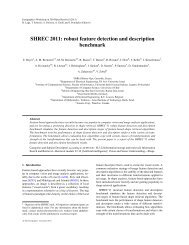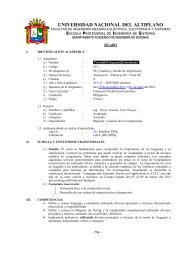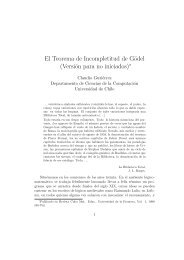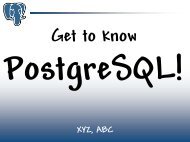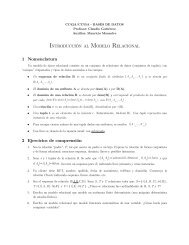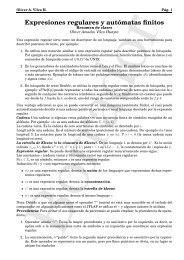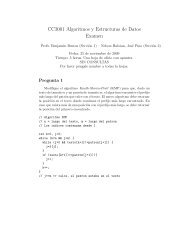Automata theory for XML researchers - Department of Computer ...
Automata theory for XML researchers - Department of Computer ...
Automata theory for XML researchers - Department of Computer ...
You also want an ePaper? Increase the reach of your titles
YUMPU automatically turns print PDFs into web optimized ePapers that Google loves.
5 DiscussionWe recalled the definition <strong>of</strong> unranked tree automataand provided some examples <strong>of</strong> applications in thecontext <strong>of</strong> <strong>XML</strong>. In addition to tree automata, someother <strong>for</strong>malisms regained attention in the area <strong>of</strong>databases:Tree-walking. The tree-walking paradigm datesback from the early research on compilers andattribute grammars [1, 6]. Tree-walking automataare still considered in <strong>for</strong>mal language<strong>theory</strong> as the connection with tree automatais still unknown [7, 8, 25]. In the context <strong>of</strong><strong>XML</strong>, the tree-walking paradigm attracted attentionas an abstraction <strong>of</strong> <strong>XML</strong> query languages[2, 17, 23] and streaming [33].Infinite alphabets. The framework considered inthis paper is limited in two ways. It assumesthat the element names <strong>of</strong> <strong>XML</strong> documents arefrom a finite and known set and it ignores thedata values in the leaf nodes and attributes <strong>of</strong><strong>XML</strong> documents. For this reason, the work <strong>of</strong>Kaminski and Francez [11] on automata on infinitealphabets has been reexamined from an<strong>XML</strong> perspective [28, 23].We mention that Miklau and Suciu obtained atranslation <strong>of</strong> XPath expressions to ranked tree automatathrough an involved simulation [16]. Thetranslation shows how the different XPath languageconstructs parameterize the complexity <strong>of</strong> the XPathcontainment problem. Although a direct translation<strong>of</strong> that XPath fragment to unranked automata is immediate,it is not clear at the moment whether thereis an easy translation to unranked tree automatawhich gives the same parameterized results <strong>for</strong> containment.The main problem is the filter predicateas each predicate introduces a conjunction.AcknowledgmentThe author thanks Dan Suciu, Leonid Libkin, JanVan den Bussche, Wim Martens, and Stijn Vansummeren<strong>for</strong> comments on an earlier version <strong>of</strong> this paper.References[1] A. V. Aho and J. D. Ullman. Translations on a contextfreegrammar. In<strong>for</strong>m. and Control, 19:439–475, 1971.[2] G. J. Bex, S. Maneth, and F. Neven. A <strong>for</strong>mal model <strong>for</strong>an expressive fragment <strong>of</strong> XSLT. In<strong>for</strong>mation Systems,27(1):21–39, 2002.[3] A. Brüggemann-Klein, M. Murata, and D. Wood. Regulartree and regular hedge languages over unranked alphabets:Version 1, april 3, 2001. Technical Report HKUST-TCSC-2001-0, The Hongkong University <strong>of</strong> Science andTechnology, 2001.[4] A. Brüggemann-Klein and D. Wood. Caterpillars: A contextspecification technique. Markup Languages, 2(1):81–106, 2000.[5] M. Consens and T. Milo. Algebras <strong>for</strong> querying text regions:Expressive power and optimization. Journal <strong>of</strong><strong>Computer</strong> and System Sciences, 3:272–288, 1998.[6] P. Deransart, M. Jourdan, and B. Lorho. Attribute Grammars:Definition, Systems and Bibliography, volume 323<strong>of</strong> Lecture Notes in <strong>Computer</strong> Science. Springer, 1988.[7] J. Engelfriet and H. J. Hoogeboom. Tree-walking pebbleautomata. In J. Karhumki, H. Maurer, G. Paun, andG.Rozenberg, editors, Jewels are <strong>for</strong>ever, contributions toTheoretical <strong>Computer</strong> Science in honor <strong>of</strong> Arto Salomaa,pages 72–83. Springer-Verlag, 1999.[8] J. Engelfriet, H.J. Hoogeboom, and J.-P. van Best. Tripson trees. Acta Cybernetica, 14:51–64, 1999.[9] G. Gottlob and C. Koch. Monadic datalog and the expresivepower <strong>of</strong> languages <strong>for</strong> web in<strong>for</strong>mation extraction.In Proc. 21th Symposium on Principles <strong>of</strong> Database Systems(PODS 2002), pages 17–28. ACM Press, 2002.[10] H. Hosoya and B. C. Pierce. Regular expression patternmatching <strong>for</strong> <strong>XML</strong>. In Proceedings <strong>of</strong> 28th Symposiumon Principles <strong>of</strong> Programming Languages (POPL 2001),pages 67–80. ACM Press, 2001.[11] M. Kaminski and N. Francez. Finite-memory automata.Theoretical <strong>Computer</strong> Science, 134(2):329–363, 1994.[12] N. Klarlund, A. Moller, and M. I. Schwartzbach. TheDSD schema language. In Proceedings <strong>of</strong> the 3th ACMSIGSOFT Workshop on Formal Methods in S<strong>of</strong>twarePractice (FMSP 2000), 2000.[13] D. Lee, M. Mani, and M. Murata. Reasoning about <strong>XML</strong>schema languages using <strong>for</strong>mal language theor. Technicalreport, IBM Almaden Research Center, 2000. Log#95071.[14] S. Maneth and F. Neven. Structured document trans<strong>for</strong>mationsbased on XSL. In R. Connor and A. Mendelzon,editors, Research Issues in Structured and SemistructuredDatabase Programming (DBPL’99), volume 1949 <strong>of</strong> LectureNotes in <strong>Computer</strong> Science, pages 79–96. Springer,2000.7




